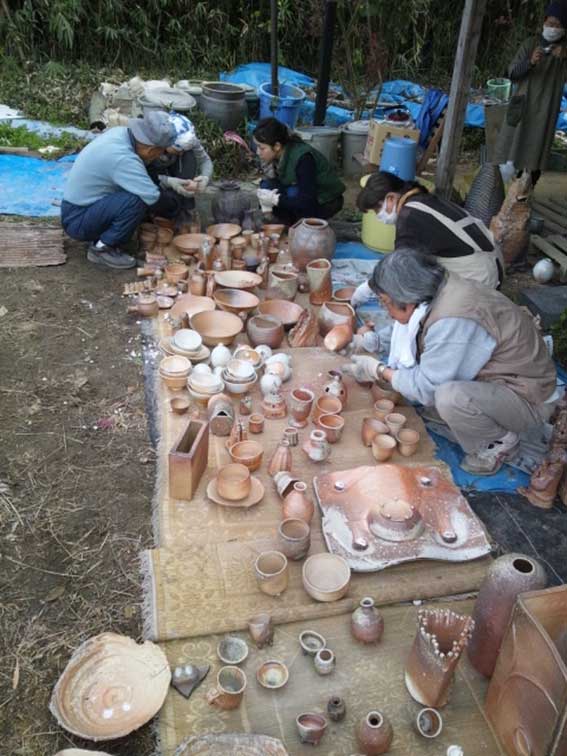Japanese Potteries(Explanations to the technical terms of ceramics No.19)
There are various technical words on potteries. Here are some of those, for which I'd like to give you some remarks.
Anagama (Taking Out from Kiln)
The temperature had slowly came lower and lower after kiln-firing was stopped, and 4 days later, it became possible to take out works from the kiln. It was still warm inside as if there were a heater. The bricks over the ground were still very hot, and we decided to spread cardboards all over the surface for working there.We had spent anxious times while waiting till the kiln cooled down, dwelling what if the things we have done spending a lot of time and fuel came to nothing. That tension continued until the moment we opened the entrance of the kiln. After opening, first of all, we raked the ashes from the fireplace. The ashes can be used as a glaze later, so we collect them carefully into a place. In the case like this time of firing unglazed works, the ashes scattered over the surface of them are melted as a natural glaze and make a nice texture even merely with that alone.
The works that had been just left laid down intentionally around the fireplace, technically called “korogashi (rolling over)”, showed their appearance in the ashes. This technique of “korogashi” can be used only in a limited area around the front of the kiln, where there are some risks that the works go broken by firewood hitting or by rapid change of temperature, however, if successful, it makes so interesting varied expressions of the works. If a work is colored in dark purple or pink, it means that it was deep in ashes all the time and got strongly deoxidized. Ashes were not completely melted and created a rough skin of pottery from which we can feel the wildness of a firewood kiln. Some tall works being stood a little away from the fireplace may get beautifully reduced or slightly deoxidized in their upper side while strongly deoxidized in the lower side buried in the ashes, which is interesting having several expressions to see. It often happens that the works especially nearby the fireplace are deformed by the heat of ferocious flame, so a certain thickness of them and the sufficient strength of the clay material itself to resist the heat are required.
The atmosphere of works changes as the distance goes longer from the fireplace. The works around the fireplace get deoxidized and have plenty natural glazes poured down which are colored likely in yellow green, while those in the deeper place get oxidized instead and less ashes reach there that makes colors like yellow or brown partially. This is because the structure of the kiln. The firewood is kept thrown into the fireplace and oxygen is rapidly consumed at all times to burn the new fuel. The stacked charcoal also takes oxygen, and as the result, the reduced condition is retained due to the deficiency of oxygen. On the other hand, in the deeper place in which there is no charcoal, the flame flowing toward the flue is constantly provided with oxygen and the oxidized flame hits the works. Such gradual change by location does not happen if the type of kiln is with partition walls, in which the atmosphere of works can be intentionally changed by room. Therefore, it is one of the unique characteristics of anagama.

Various Works Taken Out from the Kiln
In this time, we could have many nice scarlet (or orange)-colored works. This might have something to do with how it has been cooled down. The works constantly exposed by flame are already with the attachment of ingredients that will turn orange, but it is necessary to be slowly cooled down to change the color. The slower it goes cooler, the brighter the orange color will be. Straight after fire was stopped, they close the entrance of fireplace as well as the path to the flue. They also close with soil all of other holes from which smoke billows out, by which and because the ground has been burnt thoroughly, the heat inside can hardly go away. Therefore, the whole part of the kiln keeps holding heat, which becomes cooler and cooler very slowly.
When the works brought out of the kiln are nicer than expected, the nervous feeling that we had goes away and we can keep working pleasantly. Removing the burrs and polishing up the surface of works, we begin to feel kind of affection and are fascinated watching them for a while. At the same time, we also have kind of ambition for next firing with new ideas coming up in mind. The works that God blessed exceeding human power turns to something that can’t be existed by human abilities. I thought that the great thing about fire kilns is in something like such gambling. It was really a pleasure this time as we could have but great works, which blew away the exhaustion of firing work through days and nights and made us feel aggressive to challenge firing again.
